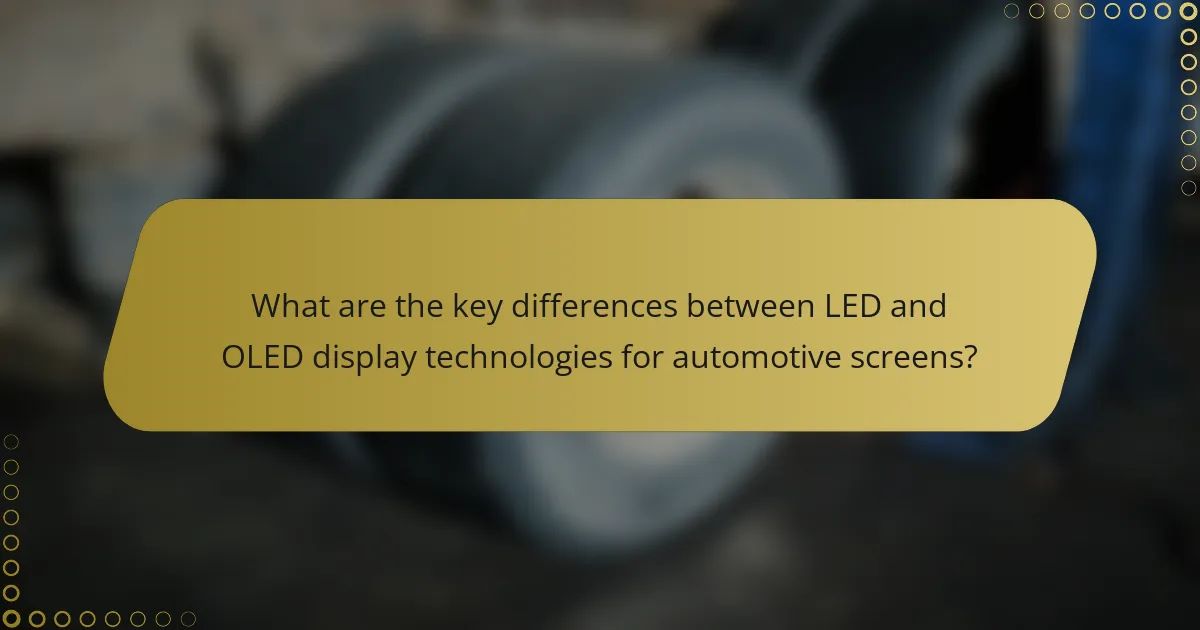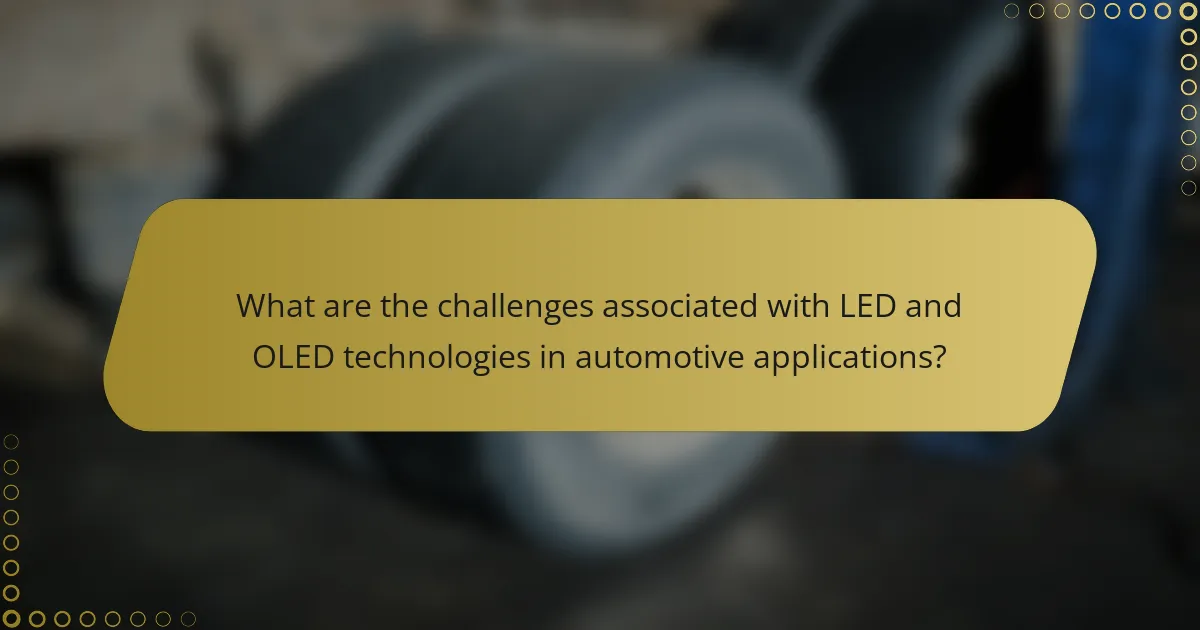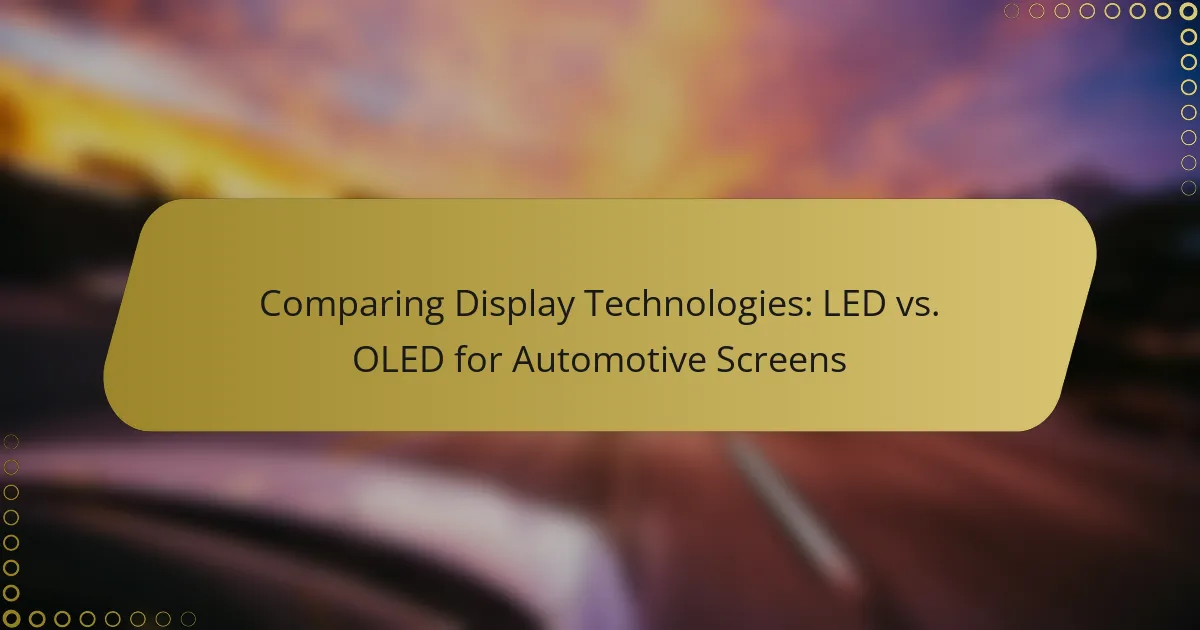The article compares two prominent display technologies used in automotive screens: LED (Light Emitting Diode) and OLED (Organic Light Emitting Diode). It highlights the fundamental differences between these technologies, such as LED’s backlighting versus OLED’s self-emissive pixels, which results in OLED’s superior contrast and color accuracy. The article also addresses the challenges faced by both technologies in automotive applications, including performance in extreme temperatures, visibility under direct sunlight, and issues like burn-in for OLEDs. Additionally, it discusses the user experience improvements offered by each technology, emphasizing LED’s brightness and longevity alongside OLED’s vibrant colors and design flexibility.

What are the key differences between LED and OLED display technologies for automotive screens?
LED displays utilize a backlight to illuminate pixels, while OLED displays emit light directly from each pixel. This fundamental difference results in OLED screens offering deeper blacks and higher contrast ratios. LED technology generally provides brighter images, making it preferable for outdoor visibility. OLED displays have a wider viewing angle compared to LED, enhancing color accuracy from different perspectives. Additionally, OLED screens can be thinner and more flexible, allowing for innovative designs in automotive applications. However, LED displays typically have a longer lifespan and are less prone to burn-in issues. These distinctions make each technology suitable for different automotive screen applications.
How do LED and OLED technologies function in automotive applications?
LED and OLED technologies function in automotive applications by providing illumination and display solutions. LED technology uses light-emitting diodes to produce light efficiently. It is commonly used for headlights, taillights, and interior lighting in vehicles. LEDs offer high brightness, low power consumption, and long lifespan, making them ideal for automotive use.
OLED technology, or organic light-emitting diode, utilizes organic compounds to emit light when an electric current is applied. OLED displays are used in dashboards and infotainment systems. They provide vibrant colors, high contrast ratios, and wide viewing angles. OLEDs are thinner and more flexible than LEDs, allowing for innovative design possibilities in vehicle interiors.
Both technologies enhance visibility and aesthetic appeal in automotive applications. LEDs are favored for their durability and efficiency in lighting, while OLEDs excel in display quality and design flexibility.
What are the fundamental principles behind LED displays?
LED displays operate based on the principle of electroluminescence. This involves the emission of light from a semiconductor material when an electric current passes through it. Each pixel in an LED display consists of red, green, and blue diodes. These diodes combine to produce a full spectrum of colors.
LED technology enables high brightness and energy efficiency. This makes LED displays suitable for various lighting conditions. Furthermore, LED displays have a longer lifespan compared to traditional display technologies. They can also be made thinner and lighter, which is advantageous for automotive applications.
In automotive screens, the use of LED technology enhances visibility and clarity. The brightness levels can be adjusted to improve readability in sunlight. Overall, LED displays provide a reliable and effective solution for modern display needs.
How do OLED displays operate differently from LED?
OLED displays operate differently from LED displays primarily because OLED technology uses organic compounds to emit light. In OLED displays, each pixel generates its own light, allowing for deeper blacks and higher contrast ratios. This is in contrast to LED displays, which use a backlight to illuminate pixels, resulting in less precise control over black levels. OLED’s self-emissive nature enables thinner screens and more flexible designs. Additionally, OLED displays can achieve faster response times compared to LED displays, enhancing motion clarity. These operational differences lead to variations in color accuracy and viewing angles, with OLED generally providing superior performance in these areas.
What advantages do LED displays offer for automotive screens?
LED displays offer several advantages for automotive screens. They provide high brightness levels, which improve visibility in various lighting conditions. LED technology also ensures lower power consumption compared to traditional display methods. This efficiency contributes to better fuel economy in vehicles. Additionally, LED displays have a longer lifespan, reducing the need for frequent replacements. They are also more robust, making them resistant to vibrations and temperature fluctuations. Furthermore, LED screens support a wide color gamut, enhancing the overall visual experience. These characteristics make LED displays a popular choice for modern automotive applications.
How does brightness impact visibility in LED displays?
Brightness directly impacts visibility in LED displays. Higher brightness levels enhance visibility in various lighting conditions. For instance, bright displays are easier to read in direct sunlight. A study by the Society for Information Display indicates that displays with at least 1000 nits are optimal for outdoor use. Conversely, low brightness can lead to poor visibility in bright environments. Therefore, brightness is crucial for effective viewing in LED displays.
What are the cost implications of using LED technology?
Using LED technology generally results in lower long-term costs compared to traditional display technologies. Initial investments in LED displays may be higher, but they offer significant energy savings. LEDs consume up to 75% less energy than incandescent bulbs. This reduction leads to decreased electricity bills over time. Additionally, LED displays have a longer lifespan, often exceeding 25,000 hours. This longevity reduces replacement costs and maintenance expenses. The total cost of ownership for LED technology is often more favorable when considering these factors.
What benefits do OLED displays provide for automotive screens?
OLED displays provide superior image quality for automotive screens. They deliver deeper blacks and more vibrant colors compared to traditional LED displays. This results in enhanced contrast ratios, which improve visibility in various lighting conditions. OLED technology allows for wider viewing angles, ensuring that images remain consistent from different perspectives. Additionally, OLED displays are thinner and lighter, contributing to overall design flexibility in vehicle interiors. They also consume less power when displaying darker images, which can improve energy efficiency in electric vehicles. Overall, these benefits make OLED displays a compelling choice for modern automotive applications.
How does color accuracy compare between OLED and LED displays?
OLED displays generally offer superior color accuracy compared to LED displays. OLED technology allows each pixel to emit its own light, resulting in deeper blacks and a wider color gamut. This capability leads to more vibrant and true-to-life colors. In contrast, LED displays rely on backlighting, which can lead to color distortion and less precise color reproduction. Studies show that OLED displays can cover over 100% of the sRGB color space, while typical LED displays often cover around 80-90%. This difference is significant for applications requiring high color fidelity, such as automotive screens.
What are the implications of viewing angles in OLED technology?
Viewing angles in OLED technology significantly impact image quality and user experience. OLED displays maintain consistent color accuracy and brightness levels across wide viewing angles. This characteristic enhances visibility for multiple passengers in automotive settings. Research indicates that OLED screens can achieve viewing angles up to 180 degrees without color distortion. In contrast, traditional LED displays often suffer from reduced brightness and color shifts at wider angles. This advantage makes OLED technology preferable for automotive applications, where varied viewing positions are common.

What are the challenges associated with LED and OLED technologies in automotive applications?
LED and OLED technologies face several challenges in automotive applications. One major challenge is the varying performance in extreme temperatures. LEDs can degrade in high heat, while OLEDs may suffer from cold weather issues. Another challenge is the visibility under direct sunlight. Both technologies can struggle with glare, affecting driver safety. Additionally, OLEDs have a risk of burn-in, which can lead to permanent image retention over time. Cost is also a significant factor; OLEDs are generally more expensive to produce than LEDs. Furthermore, the durability of OLEDs is a concern, as they are more susceptible to moisture and environmental factors. Overall, these challenges impact the adoption and effectiveness of LED and OLED technologies in automotive displays.
What limitations do LED displays face in automotive environments?
LED displays face several limitations in automotive environments. One major limitation is visibility in direct sunlight. High ambient light can wash out the display, making it hard to read. Another limitation is temperature sensitivity. Extreme temperatures can affect performance and lifespan. Additionally, LED displays may have limited viewing angles. This can hinder visibility for passengers seated at different angles. Lastly, power consumption can be higher compared to alternatives like OLED. This can affect battery life in electric vehicles. These limitations highlight the challenges of using LED technology in automotive applications.
How does heat generation affect LED performance?
Heat generation negatively affects LED performance. Increased temperatures can lead to reduced light output and efficiency. LEDs typically operate best at cooler temperatures. When the junction temperature rises, the luminous efficacy decreases. This phenomenon is known as thermal droop. Excessive heat can also shorten the lifespan of LEDs. For example, a study found that operating an LED at high temperatures can reduce its lifespan by up to 50%. Proper thermal management is essential to maintain optimal performance. Heat sinks and cooling systems are often used to mitigate these effects.
What are the durability concerns with LED displays in vehicles?
LED displays in vehicles face several durability concerns. They can be susceptible to damage from extreme temperatures. High heat can lead to reduced lifespan and performance degradation. Cold temperatures can also affect the display’s responsiveness. Additionally, LED displays may be vulnerable to moisture ingress. Water exposure can cause short circuits and failure. Physical impacts, such as vibrations and shocks from driving, can also lead to display damage. Furthermore, UV exposure can result in fading and discoloration over time. These factors collectively impact the reliability and longevity of LED displays in automotive applications.
What challenges are unique to OLED displays in automotive settings?
OLED displays face several unique challenges in automotive settings. One major challenge is susceptibility to burn-in. This occurs when static images persist on the screen, leading to permanent ghosting effects. Another challenge is limited brightness compared to LED displays. OLEDs may struggle to achieve the high luminance required for direct sunlight visibility. Additionally, OLED displays can have shorter lifespans, particularly in blue subpixels, which degrade faster than red and green. Temperature sensitivity is also a concern; extreme heat can affect performance and longevity. Finally, the cost of OLED technology remains higher than that of traditional LED displays, impacting overall vehicle pricing.
How does burn-in affect the lifespan of OLED screens?
Burn-in negatively affects the lifespan of OLED screens. This phenomenon occurs when static images persist on the display, causing uneven wear on the organic compounds used in OLED technology. As a result, the affected areas can appear dimmer compared to others, leading to a degraded viewing experience. Research indicates that burn-in can reduce the effective lifespan of OLED screens by creating permanent image retention. Studies show that the longevity of OLED displays can be significantly impacted if static content is displayed for extended periods. Therefore, users should be cautious about displaying static images to maintain optimal performance and lifespan.
What are the issues related to manufacturing OLED displays for automotive use?
Manufacturing OLED displays for automotive use faces several issues. One major challenge is the high cost of production. This includes the expense of materials and complex manufacturing processes. Another issue is the durability of OLED technology. OLED displays can suffer from burn-in and reduced lifespan compared to other display types. Additionally, they may have issues with brightness and visibility in direct sunlight. Temperature fluctuations can also affect performance and reliability. These factors contribute to the hesitance of some manufacturers to adopt OLED displays for automotive applications.

How do LED and OLED technologies impact user experience in vehicles?
LED and OLED technologies significantly enhance user experience in vehicles through improved visibility and visual quality. LED displays provide bright, energy-efficient lighting, ensuring clear visibility in various driving conditions. They have a longer lifespan compared to traditional displays, reducing maintenance needs. OLED displays offer superior contrast ratios and vibrant colors, enhancing the aesthetic appeal of vehicle interiors. They can produce deeper blacks due to their ability to turn off individual pixels. This feature improves readability in direct sunlight. Additionally, OLED screens are thinner and lighter, allowing for more flexible design options in vehicle dashboards. Research indicates that users prefer OLED for its superior image quality and responsiveness. These factors contribute to a more engaging and enjoyable driving experience.
What role does display technology play in driver safety and comfort?
Display technology significantly impacts driver safety and comfort. High-quality displays enhance visibility and reduce glare, improving the driver’s ability to see critical information. For example, OLED displays offer better contrast and color accuracy compared to traditional LED screens. This clarity helps drivers make quicker decisions, which is essential for safety. Additionally, adaptive brightness features in modern displays adjust to changing light conditions, minimizing eye strain. Research shows that ergonomic display positioning reduces the need for drivers to divert their attention from the road. Therefore, effective display technology contributes to a safer and more comfortable driving experience.
How does display responsiveness affect driving experience?
Display responsiveness significantly enhances the driving experience. A responsive display provides real-time feedback to the driver. This immediacy helps in quick decision-making. For instance, when a driver interacts with navigation or infotainment systems, lag can lead to frustration and distraction. Studies show that a delay of just 100 milliseconds can impair reaction times. In contrast, highly responsive displays reduce cognitive load. This allows drivers to focus more on the road. Furthermore, responsive displays improve safety by ensuring vital information is accessible instantly. Overall, enhanced display responsiveness directly correlates with improved driving safety and satisfaction.
What visual ergonomics considerations are important for automotive displays?
Visual ergonomics considerations for automotive displays include screen brightness, contrast, and glare reduction. Proper brightness ensures visibility in various lighting conditions. High contrast enhances readability of information displayed. Glare reduction minimizes reflections that can distract drivers. Additionally, text size and font choice should promote easy reading. The layout must facilitate quick information access without distraction. Color schemes should be chosen for visibility and comfort. Finally, the positioning of displays should align with the driver’s line of sight to reduce head movement. These factors collectively improve driver safety and comfort.
What are the future trends in display technologies for automotive applications?
Future trends in display technologies for automotive applications include increased adoption of OLED displays. OLED technology offers superior contrast and color accuracy compared to traditional LED displays. Enhanced flexibility in design allows for curved and irregularly shaped screens. Additionally, advancements in transparent display technology are emerging for heads-up displays (HUDs). Integration of augmented reality features is also becoming prevalent. The shift towards digital cockpit solutions is driving demand for high-resolution displays. Sustainability is influencing the development of energy-efficient display technologies. These trends are supported by ongoing research and investment in automotive display innovations.
How are advancements in display technology expected to shape automotive design?
Advancements in display technology are expected to significantly influence automotive design. Enhanced display capabilities will enable more intuitive interfaces for drivers. Technologies like OLED provide superior color accuracy and contrast, improving visibility in various lighting conditions. This leads to more engaging user experiences within the vehicle. Additionally, flexible display designs allow for innovative dashboard layouts. Such layouts can integrate multiple functionalities into a single screen. Research shows that 70% of consumers prefer vehicles with advanced digital displays. This trend indicates a shift towards user-centric automotive design. Overall, advancements in display technology are reshaping how vehicles are designed and experienced.
What innovations are on the horizon for LED and OLED technologies?
Innovations on the horizon for LED and OLED technologies include advancements in efficiency, flexibility, and color accuracy. Researchers are developing OLED materials that enhance brightness while reducing energy consumption. New manufacturing techniques are expected to lower production costs for both LED and OLED displays. Additionally, microLED technology is emerging, offering improved resolution and contrast. Flexible OLED panels are being explored for automotive applications, enabling curved displays. Enhanced color gamut capabilities are also being introduced, resulting in more vibrant images. These innovations aim to improve user experience in automotive screens significantly.
What should consumers consider when choosing between LED and OLED automotive screens?
Consumers should consider brightness, contrast, color accuracy, and cost when choosing between LED and OLED automotive screens. LED screens typically offer higher brightness levels, making them more visible in direct sunlight. OLED screens provide superior contrast ratios due to their ability to produce true blacks. Color accuracy is generally better in OLED displays, which can enhance the visual experience. However, OLED screens tend to be more expensive than their LED counterparts. Additionally, consumers should consider the longevity and potential burn-in issues associated with OLED technology. Understanding these factors can help consumers make an informed decision based on their specific needs and preferences.
The main entity of this article is the comparison between LED and OLED display technologies for automotive screens. The article outlines the fundamental differences in how these technologies operate, highlighting key attributes such as brightness, contrast, viewing angles, and durability. It discusses the advantages and limitations of each technology in automotive applications, including their impact on user experience, safety, and design flexibility. Additionally, the article addresses future trends and innovations in display technology, providing consumers with essential considerations for choosing between LED and OLED screens.
